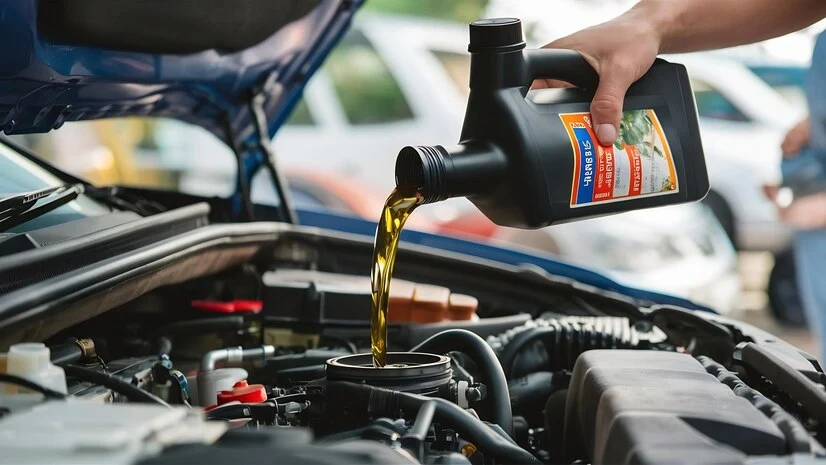Are you hearing strange engine noises or noticing warning lights flickering on your dashboard? If so, you might be facing the dreaded issue of low oil pressure when your car is idling. Fear not! In this blog post, we’ll delve into the causes of low oil pressure at idle and provide you with top tips to tackle this problem head-on. So, buckle up and let’s dive into the world of maintaining optimal oil pressure in your vehicle!
Understanding Low Oil Pressure
When it comes to your vehicle’s health, oil pressure is a crucial indicator of how well your engine is functioning. Low oil pressure at idle means that the lubrication system isn’t working as it should, potentially leading to serious engine damage if left unaddressed.
Oil pressure is the force with which oil flows through the engine to keep all moving parts properly lubricated and cooled. Without sufficient oil pressure, friction between these components increases, causing wear and tear over time.
Monitoring your oil pressure gauge regularly can help you catch any issues early on before they escalate into major problems. Understanding what causes low oil pressure can empower you to take proactive steps in maintaining your vehicle’s performance and longevity.
5 Possible Causes of Low Oil Pressure at Idle
When your vehicle’s oil pressure drops at idle, it can be a concerning issue. There are several possible causes behind this drop in oil pressure while the engine is idling.
One common reason for low oil pressure at idle could be a worn-out or faulty oil pump. If the pump isn’t functioning properly, it may struggle to circulate enough oil through the engine when running at lower speeds.
Another potential cause of low oil pressure at idle is a clogged or dirty oil filter. A blocked filter can restrict the flow of oil and lead to inadequate lubrication within the engine.
Low oil levels can also result in reduced pressure readings when the engine is idling. It’s essential to regularly check and maintain proper oil levels to prevent this issue from occurring.
Additionally, worn-out bearings or other internal components within the engine can contribute to decreased oil pressure during idle conditions.
An incorrect viscosity grade of motor oil being used in your vehicle could impact its ability to maintain optimal pressure levels at idle.
Very Low Oil Pressure at Idle When Hot
Oil Pressure is Low when Idle: If you notice very low oil pressure when your engine is hot and idling, it could be a sign of more serious issues. The heat can cause the oil to thin out, putting additional strain on the lubrication system. This can lead to decreased oil pressure as the engine struggles to maintain proper lubrication.
One possible culprit for low oil pressure when hot at idle is worn-out bearings or other internal components in the engine. Over time, these parts can wear down and create gaps where oil can leak through, causing a drop in pressure.
Another factor to consider is the quality of the oil itself. High temperatures can cause conventional oils to break down faster, leading to reduced viscosity and lower overall pressure levels. It’s essential to use high-quality synthetic oils that are designed to withstand extreme temperatures.
Regular maintenance and inspections are crucial in identifying and addressing potential causes of very low oil pressure at idle when hot. By staying proactive and addressing any issues promptly, you can help prevent serious damage to your engine in the long run.
Tips for Dealing with Low Oil Pressure
Checking the oil level is the first step in addressing low oil pressure when idle. Make sure your vehicle has enough oil to maintain proper lubrication and pressure within the engine.
Monitoring oil viscosity is crucial. Use the recommended grade of oil for your car to ensure optimal performance, especially during idling when pressure tends to drop.
Addressing engine wear is essential as worn-out components can contribute to low oil pressure issues. Regular maintenance and timely repairs can help prevent further damage.
Inspecting the oil pressure gauge regularly can give you early warnings of potential problems. If you notice fluctuations or consistently low readings, it’s time to investigate further.
Maintaining the oil pump is key to ensuring proper circulation of oil throughout the engine. A well-functioning pump helps maintain adequate pressure levels even at idle speed.
Regularly replacing the oil filter is a simple yet effective way to prevent clogs that may lead to decreased oil pressure. Stay proactive with filter changes for optimal engine health.
Checking the Oil Level
One of the first things to do when facing low oil pressure at idle is to check the oil level in your vehicle. Ensuring that your engine has enough oil is crucial for proper lubrication and maintaining optimal pressure levels.
To start, locate the dipstick under the hood and pull it out. Wipe it clean with a cloth, reinsert it fully, then pull it out again to get an accurate reading. The oil level should fall between the minimum and maximum markers on the dipstick.
If you find that the oil level is below the minimum mark, add more oil as needed according to your vehicle’s specifications. Remember not to overfill, as this can also lead to issues with oil pressure.
Regularly checking your oil level can help prevent potential problems associated with low oil pressure while idling, keeping your engine running smoothly.
Monitoring Oil Viscosity
Monitoring oil viscosity is crucial when dealing with low oil pressure at idle. Viscosity refers to the thickness of the oil and how well it can flow through the engine components.
Thicker oil may not flow efficiently, leading to decreased oil pressure, especially when the engine is idling. On the other hand, if the oil is too thin, it might not provide sufficient lubrication which could result in increased wear on engine parts.
Regularly checking and maintaining proper viscosity levels by following manufacturer recommendations can help ensure optimal performance of your vehicle’s engine.
If you notice changes in oil consistency or suspect issues with viscosity, consult a professional mechanic for further evaluation and potential solutions to prevent low oil pressure at idle.
Addressing Engine Wear
When it comes to dealing with low oil pressure at idle, addressing engine wear is crucial. Engine wear can lead to decreased oil pressure due to worn-out components within the engine. Over time, friction and heat cause parts like bearings and piston rings to deteriorate, affecting oil circulation.
To address engine wear and maintain adequate oil pressure, regular maintenance is key. Ensuring timely oil changes using high-quality lubricants can help reduce wear on critical engine parts. Additionally, monitoring the overall health of your engine through routine inspections can help detect any signs of excessive wear early on.
If left unchecked, engine wear can exacerbate low oil pressure issues and potentially lead to more severe damage over time. By proactively addressing engine wear through proper maintenance practices, you can prolong the life of your vehicle’s engine and ensure optimal performance in the long run.
Inspecting Oil Pressure Gauge
When dealing with low oil pressure at idle, it’s crucial to inspect the oil pressure gauge regularly. The oil pressure gauge provides valuable insights into the health of your engine by indicating the level of pressure in the system.
Start by checking if the gauge is functioning correctly and accurately reflecting the actual oil pressure. Look for any signs of damage or malfunction that may be affecting its readings. It’s essential to ensure that you have an accurate understanding of your engine’s oil pressure levels.
If you notice any discrepancies or fluctuations in the readings, it could be a sign of underlying issues such as a faulty sensor or a clogged filter. Addressing these issues promptly can help prevent further damage to your engine and maintain optimal performance.
Regularly monitoring and inspecting your oil pressure gauge can help you stay proactive in identifying potential problems early on, allowing for timely intervention and maintenance. Remember, staying vigilant with routine checks can ultimately save you from costly repairs down the line.
Maintaining Oil Pump
Maintaining the oil pump in your vehicle is crucial for ensuring proper lubrication and preventing low oil pressure issues. Regular maintenance of the oil pump involves checking for any signs of wear or damage that could affect its performance.
One important aspect of maintaining the oil pump is to ensure that it is properly lubricated with clean engine oil. This helps to reduce friction and prolong the life of the pump.
Additionally, it’s essential to keep an eye on the condition of the oil pump gears and shafts. Any wear or damage to these components can lead to a drop in oil pressure at idle.
Regularly inspecting and cleaning the pickup tube screen is also vital for maintaining optimal oil flow through the pump. A clogged screen can restrict oil flow, resulting in low oil pressure readings.
Following your vehicle manufacturer’s recommended maintenance schedule for servicing the oil pump can help prevent potential issues before they arise. By staying proactive with maintenance tasks, you can ensure that your oil pump operates efficiently, helping to maintain adequate oil pressure levels at all times.
Regularly Replacing Oil Filter
Regularly replacing your oil filter is crucial in maintaining optimal oil pressure levels when your engine is idle. Over time, the oil filter can become clogged with debris and contaminants, restricting the flow of clean oil to vital engine components. This restriction can lead to a drop in oil pressure, especially at idle speeds.
By changing your oil filter according to the manufacturer’s recommendations, you ensure that fresh, clean oil can circulate freely through the engine. This helps to prevent any buildup of sludge or particles that may impede proper lubrication and cause low oil pressure issues.
A new, properly functioning oil filter plays a key role in protecting your engine from premature wear and potential damage. It helps trap harmful contaminants before they have a chance to circulate through the system and cause harm.
Investing in regular maintenance like replacing your oil filter not only promotes healthy engine performance but also extends the lifespan of your vehicle overall. So don’t overlook this simple yet essential step in keeping your car running smoothly.
Importance of Oil Pressure
Why Oil Pressure Is Important
Oil pressure plays a crucial role in keeping your engine running smoothly. It ensures that all moving parts are properly lubricated, reducing friction and preventing wear and tear. Adequate oil pressure is vital for maintaining the longevity and efficiency of your vehicle’s engine.
The viscosity of the oil affects its ability to create and maintain proper oil pressure levels. Thicker oils can help increase pressure, while thinner oils may struggle to provide adequate lubrication at idle or under high temperatures.
Low oil pressure can lead to serious consequences such as engine damage, reduced performance, and potential breakdowns. Ignoring low oil pressure warnings could result in costly repairs or even total engine failure.
Regular maintenance, including checking oil levels, monitoring viscosity, and addressing any signs of engine wear promptly, can help prevent issues related to low oil pressure. By taking these proactive measures, you can minimize the risk of experiencing problems associated with inadequate lubrication in your vehicle’s engine.
Why Oil Pressure Is Important
Oil pressure plays a crucial role in keeping your engine running smoothly. It ensures that all moving parts are properly lubricated, reducing friction and wear. Without sufficient oil pressure, the engine components can grind against each other, leading to costly damage and potentially catastrophic failures.
Maintaining optimal oil pressure helps regulate the temperature of the engine by carrying heat away from vital components. This prevents overheating and extends the lifespan of your vehicle. Proper oil pressure also contributes to fuel efficiency as it allows the engine to operate efficiently without unnecessary strain.
In addition, maintaining adequate oil pressure is essential for ensuring that all parts of the engine work together seamlessly. It promotes smoother performance, quieter operation, and overall reliability on the road. Regularly monitoring and addressing any issues with oil pressure can help prevent major mechanical problems down the line.
Impact of Viscosity
Oil viscosity plays a crucial role in maintaining adequate oil pressure levels in your engine. The viscosity of the oil refers to its thickness or resistance to flow, impacting how well it can lubricate engine components. When oil is too thin (low viscosity), it may struggle to create enough pressure at idle, leading to potential damage.
Conversely, if the oil is too thick (high viscosity), it might not flow efficiently through the engine’s intricate parts when idling, causing increased friction and heat. This can result in further drops in oil pressure levels and potentially harm your engine over time.
It’s essential to choose an oil with the right viscosity grade recommended by your vehicle manufacturer for optimal performance. Regularly checking and maintaining proper oil viscosity will help ensure that your engine operates smoothly and efficiently even at idle speeds.
Reasons for Low Oil Pressure
Low oil pressure at idle can be caused by a variety of factors, each potentially leading to engine problems if not addressed promptly. One common reason for low oil pressure is a leak in the system, which can result from deteriorated gaskets or seals. These leaks allow precious oil to escape and reduce the overall pressure within the engine.
Another possible cause of low oil pressure could be a failing oil pump. The pump is responsible for circulating oil throughout the engine, so any malfunction can lead to inadequate lubrication and decreased pressure levels. Additionally, worn-out bearings or internal components can create excessive clearance that hinders proper oil flow and results in diminished pressure readings.
Furthermore, using the wrong type of motor oil or operating with insufficient levels can also contribute to low oil pressure issues. It’s crucial to ensure you’re using the correct viscosity grade recommended by your vehicle manufacturer and regularly checking and topping up your oil levels as needed.
Reducing the Risk of Low Oil Pressure
To reduce the risk of low oil pressure at idle, it’s crucial to stay on top of your vehicle maintenance. Regularly scheduled oil changes are paramount in keeping your engine running smoothly. Ensure you use the recommended oil viscosity for your specific vehicle to maintain optimal lubrication and prevent excessive wear and tear on engine components.
In addition to changing the oil, make sure to replace the oil filter as per manufacturer recommendations. A clogged or dirty filter can restrict oil flow and lead to a drop in pressure. Keep an eye on any warning signs such as knocking noises or illuminated dashboard lights that could indicate potential issues with your oil pressure.
Another way to reduce the risk of low oil pressure is by addressing any leaks promptly. Leaking seals or gaskets can cause a loss of oil, leading to inadequate lubrication and decreased pressure levels. By staying proactive with maintenance tasks and addressing any concerning symptoms early on, you can help mitigate the chances of experiencing low oil pressure when idling in your vehicle.
Conclusion
To ensure your vehicle runs smoothly, it’s crucial to address low oil pressure when idle promptly. By understanding the causes and implementing the tips mentioned above, you can maintain optimal oil pressure levels and prolong the life of your engine. Remember, regular maintenance is key to preventing issues like low oil pressure at idle. Stay proactive and keep an eye on your oil pressure gauge to catch any potential problems early on. Your car will thank you with better performance and longevity.











